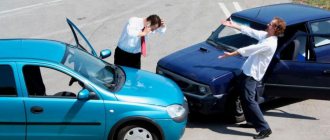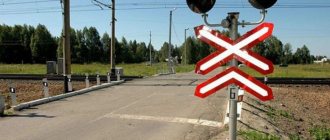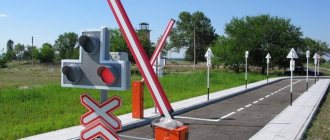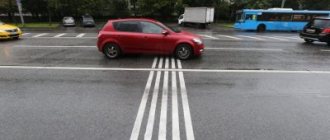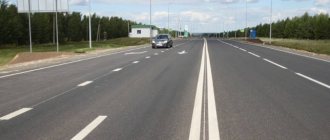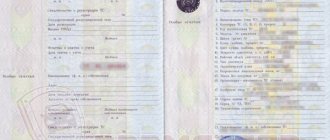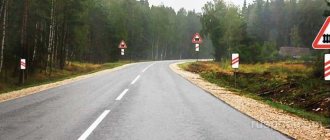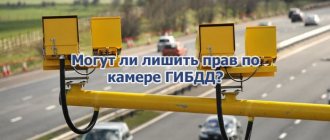Railroad crossings are considered areas of increased danger for road users. Therefore, liability for violating the rules for traveling through them will be strict. For violations committed by drivers in this case, fines may be imposed, and sometimes the driver’s license will be confiscated.
The increased severity of punishments is provided because when driving through particularly dangerous areas, the person behind the wheel endangers not only his life and health, but also poses a threat to other road users.
Fines and/or other penalties
It is strictly forbidden to stop vehicles at railway crossings.
Stopping at a crossing is punishable by a fine - the amount is 1000 rubles according to the rules of the Administrative Code, Article 12.10, part one. A decision may also be made to punish the driver by depriving him of the right to drive a car for a period of 3-6 months (Article 12.10, Part 3).
If the violation occurs again, the offender may be disqualified from driving for one year.
They can be punished in cases where the car was stopped at any section of the crossing, except for specially designated places - the area of the stop line, the STOP sign, in front of the barrier. Having stopped in this area, the driver must assess the situation in order to avoid mistakes when crossing a high-risk zone.
For example, immediately after a crossing, a traffic jam of several cars may accumulate, due to which you will have to slow down on the railway tracks. By stopping at the stop line, you can notice the congestion in advance and avoid driving onto the tracks.
Travel without stopping
If the driver drove in the required place without making a mandatory stop in front of him, this is a violation. The sign “No driving without stopping” obliges you to stop even when the road is empty. If there is no white stop line, you must brake in front of the sign.
Violators of this rule will be fined - the amount is 1000 rubles.
Forced stop on the rails
If the driver was forced to stop at a crossing, no punishment will follow if it can be proven that the car stopped due to a breakdown.
The same is true in the case when the car in front suddenly stopped, which is why the next one had to brake. If your car breaks down and you are forced to stop, you must immediately take measures to ensure the safety of other road users:
- Passengers in a stopped car should be disembarked immediately.
- The driver must take all possible measures to clear the railway tracks as quickly as possible.
- If possible, people should be sent along the rails on both sides of the stopped car - they should move away about a kilometer and signal “Stop!” if they see an approaching train.
- Anyone who remains near the car will have to sound the horn. One long beep and three short beeps are a general alarm signal.
If you notice an approaching train, you need to add visible signals to the sound signals - make circular movements with your hand.
It is advisable to hold a clearly visible object in your hand, for example, a bright piece of fabric. At night, you should use a flashlight to signal.
Overtaking
Overtaking is a maneuver in which a car leaves its lane, gets ahead of other vehicles and returns to its original lane. When performing a maneuver, the overtaking vehicle increases speed. The maneuver of moving into the adjacent lane begins, then advance is performed, after which the car returns to the same lane from which it started.
Overtaking is prohibited at some sites, including railway crossings. It is also prohibited to overtake vehicles moving ahead at a distance of 100 meters before crossing.
For this violation, the following fines and penalties are provided:
- A fine of 5,000 rubles (Administrative Code, Art. 12.10).
- Deprivation of the offender's right to drive a car for a period of 4 months or six months.
- Repeated violation - the driver is deprived of his license for one year.
If overtaking was carried out without entering the oncoming lane, it is classified as overtaking. When drawing up the protocol, it must be indicated that at the crossing there were more than two lanes for traffic in one direction.
After the car passes the railroad tracks in a specially designated place, the zone where overtaking is prohibited is over. If there are no signs that prevent cars from overtaking on this section of roads, the maneuver can be performed freely without fear of penalties.
Stopping at and in front of a railway crossing
So, let's look at the rules for stopping at and near a railway crossing. To do this, let's turn to paragraph 12.4 of the traffic rules:
12.4. Stopping is prohibited: ...
- at railway crossings, in tunnels, as well as on overpasses, bridges, overpasses (if there are less than three lanes for traffic in a given direction) and under them;
Those. stopping is prohibited only at the railway crossing itself (zone 1 in the picture).
In addition, there is one more point of the traffic rules related to stopping at a railway crossing:
15.3. It is forbidden to travel to move: ...
- if there is a traffic jam behind the crossing that will force the driver to stop at the crossing;
In principle, these points of the rules are in many ways reminiscent of the points of Section 13, relating to the passage of intersections and prohibiting continued movement in the event of a congestion.
However, unlike a car at an intersection, a train will not be able to stop in front of a railroad crossing even with the great desire of the driver and all passengers, because its braking distance even at minimum speed is hundreds of meters. Well, the huge weight of the train leads to the fact that in the event of an accident, all that remains of the car in a matter of seconds is a pile of metal.
Never risk your own life and the lives of your passengers. Under no circumstances should you stop at a railroad crossing . Well, a little lower we’ll talk about what needs to be done if you have to stop at a railway crossing.
Where is it prohibited?
To correctly determine where and how to stop at and near a crossing, you should refer to the traffic rules. For ease of understanding, the entire site can be divided into zones:
- From 100 meters to the rails or more - when driving, the same rules apply as on a simple road.
- 100 meters from the rails – may be limited by signs, the same rules apply as on roads without rails.
- 50 meters – parking of any vehicle is prohibited in this zone; the rule applies to the area on both sides. If necessary, you should stop before the crossing itself, near the stop line, together with which a sign is used, according to which movement without stopping is prohibited.
- In the area for traffic that crosses the rails, you should move without any stops.
If the car has passed the stop mark and then was forced to brake due to the prohibiting signal turning on, you cannot use reverse gear. This position of the car, according to Articles 12.10, 12.19 of the Code of Administrative Offences, is also subject to a fine.
The amount of the fine depends on how the violation is classified. The driver can try to mitigate the punishment by making a statement that the barrier was open and the traffic light was green.
Parking before the railway crossing in 2021
Firstly, parking, as well as stopping, is prohibited at the railway crossing itself, i.e. in zone 1:
12.5. Parking is prohibited:
- in places where stopping is prohibited;
In addition, parking is prohibited 50 meters from railway crossings (in zone 2):
12.5. Parking is prohibited: ...
- closer than 50 m from railway crossings.
Please note that parking is prohibited on any side of the crossing, i.e. not only before the move, but also after it (within zone 2).
Permitted places
The traffic rules also indicate the distance at which a driver who is about to cross dangerous areas should stop.
Reference. If there is a 2.5 sign at a railway crossing or a special stop line, you must stop in front of it. Since the STOP sign prohibits driving without stopping, you should stop the car, assess the situation, and check for signals that may prohibit something.
Sign 2.5: “Driving without stopping is prohibited”
The choice of where the driver needs to stop before crossing depends on whether there is a barrier in front of the railway tracks. If there is a barrier, you should stop the car at least 5 meters from it. If not, you should stop 10 meters from the nearest rail.
Watch a video on the topic:
Basic rules for stopping before a railway crossing
The section of the roadway immediately before the railway crossing is divided into several zones. Each of them has its own rules:
- 100 or more meters from the tracks (zone 4). Normal driving rules on public roads apply in this area;
- from 100 to 50 meters to the rails (zone 3). The PPD does not impose separate requirements and restrictions on this zone. Drivers are warned when approaching a dangerous area using signs;
- 50 metro before and after the railway crossing (zone 2). Stopping in this zone is prohibited, since a parked vehicle interferes with the view of other traffic participants. An exception is braking in front of a STOP sign, stop line, traffic light, barrier or the tracks themselves;
- moving area (zone 1). It is indicated by the sign 1.1 – 1.3.2. This includes not only rails, but also bridges, overpasses and tunnels related to the railway. You should drive through this section without stopping, after making sure that the passage is safe.
When approaching a crossing, the driver must take into account the following factors:
- Road sign instructions.
- Signals given by traffic lights.
- Current position of the barrier (raised or lowered).
- The presence of a moving train in sight.
If one of the listed factors indicates the presence of danger and prohibits passage, then you should stop at a safe distance and wait for permission to pass.
The main rules for traveling in the first zone:
- the requirements of the traffic light signal, road signs, markings, traffic controller designations and the position of the barrier are mandatory for all traffic participants;
- if you have all the permits to travel, the driver should once again independently verify that there is no moving train in sight;
- if there are several options for regulation and designation, the controller has priority, and then mechanical means (barrier, lifting mechanism, traffic light);
- traffic light designations should be interpreted as follows: a white round flickering light is on - travel is allowed, a red flashing light is prohibited;
- if there is a traffic controller, his designations and requirements are mandatory, even if they completely or partially contradict other signals from mechanical means;
- In the absence of a traffic light, a traffic controller and a barrier, the sign “Moving without stopping is prohibited” has priority. It marks the place where the driver must stop and make sure that further passage is safe.
In what cases is it allowed?
There are situations in which stopping in front of railroad crossings, and sometimes directly at them, is a necessity. To indicate it, signals such as a red traffic light or a lowered barrier are used.
It is necessary to stop if required by a traffic controller or in cases where a moving train appears in the visibility zone.
- If you drive through a crossing without paying attention to a red light, you can receive a fine under Article 12.10 (Part 1) of the Code of Administrative Offenses in the amount of 1,000 rubles.
- If the violation is repeated, a decision may be made to deprive the driver of the right to drive a vehicle for 6 months.
The traffic controller signals the need to stop if his face or back is turned to the driver, and his hand is raised up. This signal duplicates the red color at a traffic light. If the driver sees signals in front of him that are different in meaning - for example, a traffic controller in a position prohibiting movement and a traffic light with a green light on, he should act as the traffic controller indicates.
Main aspects
Conventionally, the crossing is divided into zones that have their own traffic rules, and the closer you are to the rails themselves, the more stringent the driving requirements become.
In some of them you need to stop at a certain distance from the rails, in others stopping is completely prohibited.
In any case, you need to understand that stopping is required in any case if the prohibitory signals come on, but this must be done only in front of the tracks, and in no case on them.
If the driver does not comply with the established traffic standards, the traffic police inspector may draw up a report.
Now some crossings are equipped with video cameras that record violations, and if this is not provided, then traffic police squads are often on duty to identify offenses and punish drivers.
But even if there are no inspectors, you should follow traffic rules, because the safety of property and human lives depends on it.
Basic Concepts
To understand in which cases you can stop, and in which it is strictly prohibited, and what the inspector can assign for such violations, you need to familiarize yourself with a set of general concepts.
They may be present in legal acts and will be required to accurately characterize the situation that has arisen.
| Term | Meaning |
| Stop | Intentionally stopping the movement of a vehicle for up to 5 minutes or more, but only if this is necessary to disembark/embark passengers or to unload the vehicle |
| Parking | An intentional stop of a car, lasting more than five minutes, and it is carried out without the purpose of boarding passengers or unloading cargo, but at the request of the driver |
| Fine | An administrative measure that requires the violator to pay a fine covering possible risks and damage from the violation, and also disciplines the citizen who committed the violation |
What should be the distance
To understand how many meters from the crossing you can stop, you should refer to the Traffic Rules, which contain similar information.
First of all, you should remember that if there is a barrier at the crossing, then the car must be stopped at least five meters from it, and if there is none, then it should be kept 10 or more meters from the nearest rail.
When there is a stop sign and a corresponding line near a crossing, you need to stop right next to it, and under no circumstances drive beyond the markings.
If we are talking about prohibitions, then you cannot park at a distance of 100 meters on any side of the crossing.
Stopping in this zone is permitted, but only while waiting to cross a crossing or in case of a serious breakdown.
It is imperative to understand that maintaining a distance from the rails can help to avoid troubles, since the car may well get caught by a train, its parts or bounced cargo, if we are talking, for example, about rubble in an open carriage.
Photo: distance to railway tracks
The legislative framework
First of all, you need to remember that the main legal act for the driver, as well as the collection of all norms and rules of conduct on the road, are the Traffic Rules.
It spells out not only what signs are used and in what situations, but also completely stipulates the movement of vehicles through the railway crossing and, of course, attention is also paid to the correct equipment of the crossing.
If the norms for driving a vehicle specified in the traffic rules are violated, then the Code of Administrative Offenses comes into play, which, in addition to the offenses themselves and their full characteristics, also contains a clause on punishment.
According to this document, the inspector will make a decision on a fine or deprivation of rights, but since the driver can familiarize himself with it, if the inspector’s decision does not comply with the letter of the law, the motorist has every right to file an appeal within the period specified by the same Administrative Code.
How can the traffic police prove your guilt?
If a traffic police officer has already issued you a fine for stopping at a crossing, but you believe that you committed an unintentional action, all decisions can be challenged in court. If you are forced to stop driving, you can achieve a mitigation of the punishment.
In order to prove the driver’s guilt and confirm the fairness of their actions, the police can present to the court video or photographic materials, as well as testimonies of witnesses to the road accident.
At many sites where there is an increased danger for vehicle traffic, video cameras are installed. Often, records from them in court are used as strong evidence that the traffic police officer who drew up the violation report is right. The testimony of the person on duty at the crossing is taken into account.
All fines for railway crossings in 2021
A separate point that is highlighted in the traffic rules is compliance with the rules when crossing a railway crossing. This section of the route is more dangerous than a regular road. This is due to the speed experienced by trains and the serious consequences for vehicles and passengers that may be present when colliding with moving trains. Violation of the rules for passing such a section becomes the basis for bringing the perpetrators to justice and imposing fines.
Traffic police fines related to railway crossings
Preventive measures that apply to motorists may be as follows:
a fine for driving through a railway crossing through a red light and other types of signals prohibiting further movement;
punishment for avoiding obstacles or overtaking, if such a maneuver involves the need to enter the oncoming lane;
a fine for stopping or parking both at the crossing itself and at a prohibited distance to it;
punishment for ignoring a stop sign;
penalties for violation of other rules for traveling such a section, which, in particular, include crossing a crossing in an unspecified place.
Driving through a prohibitory traffic light
One of the most common fines for crossing railway tracks that are imposed on motorists is the penalty provided for in Part 1 of Article 12.10 of the Code of Administrative Offenses of the Russian Federation. It is determined for an attempt to pass (suppressed by traffic police officers) or direct passage to a prohibiting signal.
Such signals can be considered:
red traffic light;
a reflection of the ban on further movement, which may be indicated by the traffic controller (the person on duty at the crossing).
The latter situation may occur in the absence of technical means (traffic lights or barriers) or their temporary malfunction.
If you cross a railway crossing contrary to the rules, the driver will be held accountable and will have to pay a fine of 1 thousand rubles. As an alternative method of punishment, deprivation of rights for a period of 3 to 6 months may be applied.
Overtaking and detour
Overtaking at a railway crossing, as well as avoiding obstacles and entering oncoming traffic, is a prohibited maneuver. This prohibition is related to the content of the following paragraphs of the current version of the traffic rules:
clause 15.3, which prohibits driving around obstacles (vehicles) into oncoming traffic immediately before the crossing;
clause 11.4, which prohibits overtaking both on the crossing itself and at a distance closer than 100 meters in front of it.
Penalties in case of detour and overtaking contrary to traffic rules:
a fine of 1 to 1.5 thousand rubles (part 3 of article 12.15 of the Code of Administrative Offenses of the Russian Federation). The driver will pay this amount if he drives into the oncoming lane while avoiding an obstacle;
if the vehicle was overtaken in an oncoming lane, the fine will be 5 thousand rubles, an alternative punishment is deprivation of rights for a period of 4 to 6 months (part 4 of article 12.15 of the Code of Administrative Offenses of the Russian Federation);
if overtaking is repeated at a crossing - a fine of 5 thousand rubles (if recorded by a camera) or deprivation of rights for a period of 1 year (Part 5 of Article 12.15 of the Code of Administrative Offenses of the Russian Federation).
Stop at a crossing
According to clause 12.4 of the Traffic Regulations, railway crossings belong to the category of places where it is strictly forbidden to stop moving or park. There are penalties for such actions.
Stopping at a railway crossing will not constitute a violation only if certain circumstances were present. These include reasons related to the health of the motorist or the technical condition of the car. In accordance with clause 12.5 of the traffic rules, parking is prohibited in those places where stopping is prohibited (applicable to the situation under consideration, this is the crossing itself), as well as closer than 50 meters from it.
The penalty in case of non-compliance with the above requirements will be similar to driving through a prohibitory signal - a fine of 1 thousand rubles or deprivation of rights for a period of up to 6 months. This is provided for in Part 1 of Article 12.10 of the Administrative Code). For repeated violation - deprivation of rights for 1 year (Part 3 of Article 12.10 of the Administrative Code).
Crossing tracks without stopping
What will be the risk of crossing railway tracks without stopping and why is this a violation? Almost every such section is equipped with a “stop” sign for safety purposes, indicating the need for a short-term stop (without turning off the engine). In this case, the rules dictate:
stop just before the stop line, if present;
stop in front of the road sign itself to make sure that there is no moving train.
The fine for railway crossing without stopping is determined in accordance with Article 12.10 (Part 2) of the Code of Administrative Offenses. It is 1 thousand rubles.
Controversial situations
Violating the rules for crossing a railway crossing may involve some controversial issues in which the motorist does not agree that he has committed an offense. As an example, consider the following cases.
If the barrier began to lower or the red light turned on after the motorist entered the territory, his actions cannot be considered a violation. In such a situation, the driver should move through the area as quickly as possible to avoid a collision with a passing train.
If there is a car malfunction that caused a stop at a crossing, it is also unacceptable to impose punishment on the motorist. In such a situation, measures should be taken to ensure that all passengers get out of the car and the car itself is removed from the tracks as soon as possible.
If a motorist has already started moving through the crossing (provided the red light is on), and a traffic jam has formed behind him, he should drive forward as quickly as possible - such a maneuver also cannot be considered a violation.
In any situation when a traffic police officer or automatically (based on the recording of an installed video surveillance camera) charges a traffic violation, the driver may disagree and in response provide arguments and evidence on the basis of which prosecution will not occur.
How to pass a railway crossing correctly
The basic rules to follow when crossing such an area are as follows:
when approaching, you must be guided by the requirements of established signs, traffic lights, markings and the duty officer;
at the entrance to the crossing, you should make sure that there is no train that may be approaching;
You cannot drive onto the tracks if there are prohibiting signals or if there is a traffic jam that has formed immediately after the crossing;
It is strictly forbidden to try to open the barrier yourself;
You cannot overtake cars at crossings;
if it is necessary to stop due to a passing train and there is no traffic light, markings or signs, the minimum distance between the nearest rail and the car should be 10 meters;
If there is a forced stop and it is impossible to immediately remove the car from the tracks, it is worth sending people in both directions (from where the train may be approaching) who, through warning signals, can inform the driver that there is an obstacle on the rails.
A railway crossing is a rather dangerous section of the road, where violation of traffic rules is fraught with irreversible consequences. Only strict adherence to traffic rules will help the driver avoid being held accountable and creating an emergency situation that could lead to a collision between the car and a train moving at high speed.
Driving through a prohibitory traffic light
One of the most common fines for crossing railway tracks that are imposed on motorists is the penalty provided for in Part 1 of Article 12.10 of the Code of Administrative Offenses of the Russian Federation. It is determined for an attempt to pass (suppressed by traffic police officers) or direct passage to a prohibiting signal.
Such signals can be considered:
- red traffic light;
- lowered barrier;
- a reflection of the ban on further movement, which may be indicated by the traffic controller (the person on duty at the crossing).
The latter situation may occur in the absence of technical means (traffic lights or barriers) or their temporary malfunction.
If you cross a railway crossing contrary to the rules, the driver will be held accountable and will have to pay a fine of 1 thousand rubles. As an alternative method of punishment, deprivation of rights for a period of 3 to 6 months may be applied.
Part 3 of Article 12.10 determines a more severe penalty for repeated violations. It will be expressed in deprivation of rights for a whole year. A repeated violation is considered if it is recorded within one year from the previous one.
Punishment for violation
And now about the punishment for violating parking rules at bus stops. It is provided for in Article 12.19 of the Code of Administrative Offenses:
Stopping or parking without interfering with public transport - 1000 rubles;
Parking obstructing pedestrians or public transport - a fine of 2,000 rubles.
In Moscow and St. Petersburg, the fine for these offenses is higher - 3 thousand rubles.
But a fine is not the only punishment provided for the violator. If the driver parks at a stop and leaves the car, the car will be towed to the impound lot. In this case, you will have to pay significantly more. At the same time, you may only be gone for a few minutes - the traffic police and tow trucks work quickly - 10 minutes is enough to detain a car.
Stop signs prohibited and parking prohibited
No stop sign
In addition to the conditions listed above, there is a special “No Stopping” sign in the traffic rules:
The “No Stopping” sign can be installed on any section of the road and is usually valid until the nearest intersection.
For example, this sign is installed on bridges whose boundaries the driver cannot determine while driving.
Please note that although the sign is called “No Stopping,” it prohibits not only stopping, but also parking of vehicles.
No parking sign
By analogy with the “No Stopping” sign, the traffic rules also have a “No Parking” sign:
This sign is 100 percent true to its name and only prohibits the parking of vehicles.
In addition, we should not forget about the signs “Parking prohibited on odd-numbered days” and “Parking prohibited on even-numbered days”:
Sign 3.27 prohibits both stopping and parking, 3.28 - only parking, 3.29 - parking only on odd days of the month, 3.30 - parking only on even days of the month.
Sign coverage area
Let me remind you of some features of the use of these prohibitory signs.
The signs listed above are valid from the place of their installation to the nearest intersection or to the end of the populated area. In addition, the coverage area of signs may be limited in the following ways:
1. Plaque 8.2.2 is installed together with the sign:
2. A repeat sign 3.27 – 3.30 is installed with plate 8.2.3:
3. Sign 3.31 “End of the zone of all restrictions” is installed:
4. If a sign is used in conjunction with a yellow marking line, then it is valid until the end of this marking line:
It should be remembered that signs extend their effect only to the side of the road on which they are installed. Those. if sign 3.27 is located on the right side of the road, then it does not prohibit parking the vehicle on the left side. For example, on a one-way road.

